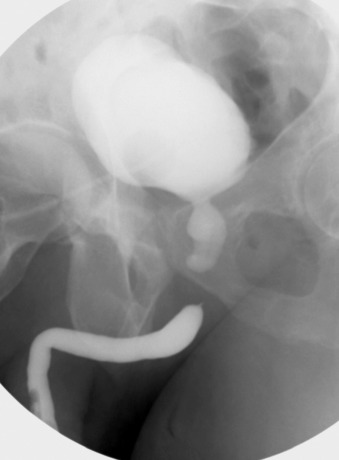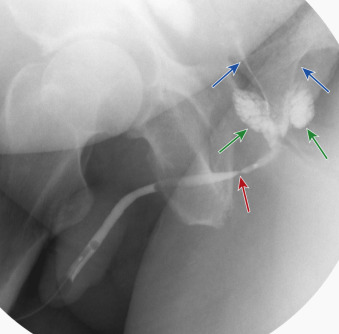Physical Address
304 North Cardinal St.
Dorchester Center, MA 02124
Urethral trauma may result from blunt, penetrating, or iatrogenic injury. The spectrum of urethral injuries includes contusion, partial or complete disruption, and urethral injury and may involve either the anterior or posterior urethral segment. Blunt anterior urethral injuries are commonly associated with perineal straddle injury, whereas posterior urethral injuries are usually a consequence of the shearing forces involved with a pelvic fracture. Penetrating injuries, including gunshot injuries, may involve both the anterior and posterior urethral segments.
Blunt trauma causes the vast majority of injuries to the posterior urethra. Urethral disruption occurs in approximately 10% of pelvic fractures. Almost all membranous urethral disruptions related to blunt trauma have an associated pelvic fracture. Urethral injuries associated with pelvic fractures are much less common in females because of its shorter length and greater mobility in relation to the pubic arch. Anterior urethral injuries commonly occur as a result of straddle injuries and rarely follow anterior pubic rami and penile fractures.
Inability to urinate, blood at the meatus, and a palpable bladder are the classic findings of urethral disruption. Other symptoms may include frank hematuria, a high-riding prostate on rectal examination, decrease in urinary stream, spraying or double stream, and postvoid dribbling. Inability to pass a urethral catheter may be the first indication of urethral injury. In delayed presentation, induration in the area of a posttraumatic stricture may be palpable.
The male urethra is anatomically subdivided at the level of the urogenital diaphragm into anterior (penile and bulbar portions) and posterior segments (membranous and prostatic portions), and the mechanism of urethral injury also may be classified along these lines. Posterior urethral injury is usually caused by a massive shearing force that results in concomitant pelvic fracture. Membranous urethral disruptions are associated with multiple organ injury, whereas anterior urethral injuries usually occur in isolation. Causes of anterior urethral injuries include straddle trauma crushing the immobile bulbous urethra against the pubic rami or a penile fracture leading to a laceration through the adjacent urethra. Iatrogenic injuries affect both anterior and posterior segments of the urethra.
Retrograde urethrography (RUG) is the study of choice in diagnosing urethral injuries. It is accurate, simple, and may be performed rapidly in the trauma setting. Extravasation of contrast agent from partial or complete disruption of the urethra is usually readily identified at urethrography. RUG permits assessment of the integrity of the anterior urethra and demonstrates gross extravasation from the posterior urethra. However, voiding cystourethrography (VCUG) may be required to completely evaluate the posterior urethra.
Several classifications of the anatomic site of urethral injury have been described. On the basis of RUG findings, Colapinto and McCallum described three types of posterior urethral injuries in 1977 (type I, II, and III injuries). Subsequently, in 1997, Goldman and associates proposed a new, expanded anatomic classification for the purposes of comparing treatment strategies and outcomes after blunt urethral trauma ( Figures 80-1 and 80-2 , Table 80-1 ).


| Types of Urethral Injury | Findings |
|---|---|
| Type I | Posterior urethra stretched but intact; no extravasation |
| Type II | Partial or complete posterior urethral disruption with tear of the membranous urethra above urogenital diaphragm; extravasation into extraperitoneal pelvis |
| Type III | Partial or complete combined anterior and posterior urethral disruption with disruption of the urogenital diaphragm; extravasation into the extraperitoneal pelvis and perineum |
| Type IV | Bladder neck injury |
| Type IVA | Injury to the bladder base with periurethral extravasation simulating a bladder neck injury (may be difficult to distinguish from type IV injury radiologically) |
| Type V | Partial or complete pure bulbous urethral disruption, due to straddle injury |
Although computed tomography (CT) is ideal for imaging upper urinary tract and bladder injuries, it has a limited role in the diagnosis of urethral injuries. Nonetheless, a recent retrospective radiographic comparison of CT findings in patients with urethrographically proved urethral injuries demonstrated CT findings of prostatic apex elevation and contrast agent extravasation above or below the urogenital diaphragm in various subclasses of urethral injury.
Magnetic resonance imaging (MRI) may have a role in evaluating complex cases, particularly when the posterior urethra is involved and delayed repair is being planned. MRI has the advantages of demonstrating periurethral tissues and of demonstrating the posterior urethra even if there is a distal stricture.
In patients with urethral injury, MRI can assess the length of urethral injury, position of the prostatic apex, and prostatic dislocation. A combination of T1- and T2-weighted images can differentiate between soft tissue edema, fibrosis, and hematoma. However, conventional MRI cannot assess the patency of the urethral lumen. ( Table 80-2 ).
| Imaging Method | Pros | Cons |
|---|---|---|
| Retrograde urethrography | Gold standard for diagnosing anterior urethral strictures Provides excellent evaluation of the anterior urethra |
Stricture length in the bulbar urethra is often underestimated. Radiation exposure. Limited evaluation of urethral tumors and complex diverticula. Periurethral tissues cannot be imaged. |
| Voiding cystourethrography | Provides excellent evaluation of the posterior urethra in men Useful in postoperative evaluation |
Limited evaluation of the anterior urethra, urethral tumors and complex diverticula. Periurethral tissues cannot be imaged. |
| Sonourethrography | More accurate in the bulbar urethra Absence of radiation exposure |
Time and cost constraints. |
| CT urethrography | Useful for the detection of urethral calculi | Radiation exposure. Lacks the sensitivity and specificity to evaluate urethral strictures. |
| MR urethrography | Periurethral tissues visualized, allowing evaluation (e.g., for spread of inflammation and tumor) | Cost constraints. Not widely available. |
Urethral ultrasonography has limited diagnostic use in the acute setting.
Become a Clinical Tree membership for Full access and enjoy Unlimited articles
If you are a member. Log in here